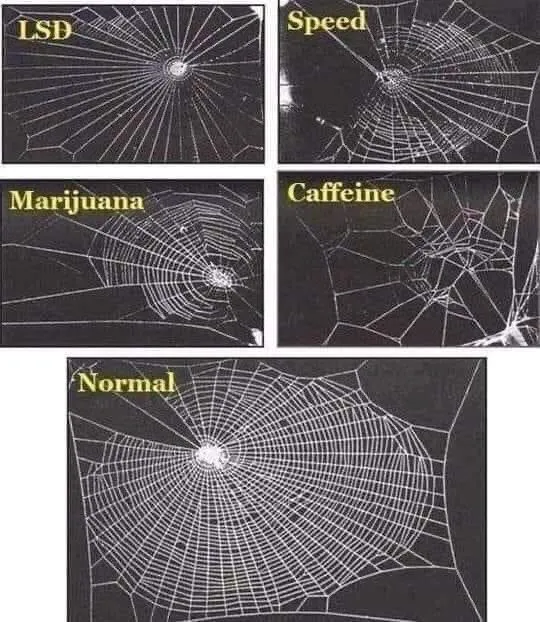Nutrition et santé
Drogues et toiles d’araignée
Le post
Voir sur
🕷️How Psychoactive Drugs Alter Spider Web Construction🕸️
In 1995, scientists explored how different drugs influence spider web construction to understand their impact on behavior and motor skills. This research was initiated due to a zoologist's request to alter the time garden spiders build their webs. The team administered various psychoactive substances, such as amphetamine, mescaline, strychnine, LSD, and caffeine, observing changes in web size and shape rather than timing.
Low caffeine doses led to smaller webs with uneven radii, while higher doses resulted in even smaller, irregular designs. Each drug induced different effects: sleeping pills caused drowsiness and incomplete webs, Benzedrine created zigzag patterns, marijuana resulted in missing inner sections, and scopolamine disrupted directional sense.
The study highlighted how drugs affect spider behavior, offering insights into the broader impacts of psychoactive substances across species.
#psychedelics #science #research #neuromodulation

Le débunk
It's true, but it doesn't really tell us anything new.
This 4-paragraph NASA publication from 1995 reiterates earlier studies (including those involving LSD) and shows that certain substances administered to spiders deform their webs.
https://cvc.li/gESzf
https://cvc.li/KtsUG
https://cvc.li/JRaru
These experiments caused quite a stir, partly because the webs are easy-to-understand illustrations.
However, these webs cannot be used to measure the toxicity of a substance on humans, contrary to what the study hoped to demonstrate.
In fact, a recent article on the subject warned against comparing the behaviour of spiders with that of mammals, and most especially with that of humans.
Correlation is not causation, as they say.
https://cvc.li/vcevi
To be sure of the effects of these substances on humans, similar studies would have to be conducted on humans, which raises ethical and legal issues, as explained in an article in the ARC Journal of Neuroscience:
https://cvc.li/CMZmY
En français :
C’est vrai mais cela ne nous apprend rien en vrai.
Cette publication de la NASA de 1995 sur 4 paragraphes, reprend des études antérieures (incluant même du LSD) et démontre que selon certain type de substances administrées aux araignées, leurs toiles sont déformées.
https://cvc.li/gESzf
https://cvc.li/KtsUG
https://cvc.li/JRaru
Ces expériences ont fait beaucoup de bruit, notamment parce que les toiles sont des illustrations faciles à comprendre.
Cependant, ces toiles ne servent pas à mesurer la toxicité d’une substance sur l’homme, contrairement à ce que l’étude espérait démontrer.
D'ailleurs, un récent article sur le sujet mettait justement en garde contre la comparaison des comportements des araignées avec ceux des mammifères et surtout avec ceux des humains.
Corrélation n’est pas causalité toussa toussa;
https://cvc.li/vcevi
Pour être sûr des effets sur l’homme de toutes ces substances et pouvoir les comparer avec les effets sur l’homme, il faudrait mener des études similaires sur des humains, mais cela pose des problèmes éthiques et légaux comme l’explique un article du journal en neuroscience de l’ARC :
https://cvc.li/CMZmY
Vous avez une question, une remarque ou une suggestion ? Contactez-nous en en indiquant le titre du débunk. Nous vous répondrons au plus vite !
Contactez-nous
